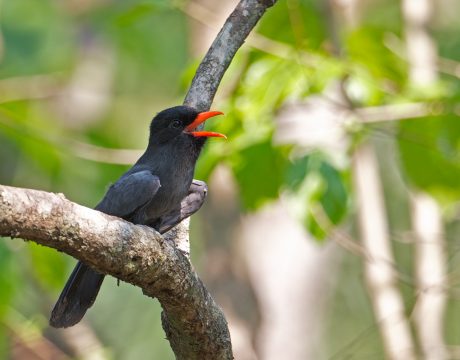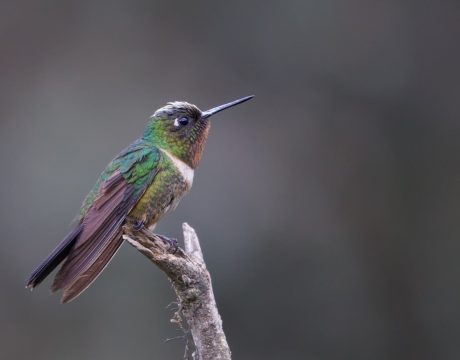Return of Bird of the Week: White-whiskered Puffbird
Another of the puffbird species that WC has been able to photograph, this one in 2010. Panama is more or less in the middle of this species’ range, which extends from Mexico to Ecuador, generally in humid evergreen forests and shady forest edges, usually pretty low in the understory. This is an ambush predator. It perches motionless on branches, where it can be remarkably hard to see, and then sallies out to capture insects, spiders, frogs or lizards, then returning to its perch to beat the prey to death on the branch before eating it. Unusually among puffbirds, it is…
Return of Bird of the Week: Lanceolated Monklet
Another member of the Puffbird family, this is the Lanceolated Monklet, one of the rarest birds WC has photographed. “Lanceolated” means “spear-shaped,” a reference to the chest and flank streaking. “Monklet” is a play on the name of its cousins, the Nunbird, but the Monklet is pretty mall, so instead of being a monk it’s a “monklet.” It’s one of the smallest members of the Puffbird family, only 5-6 inches long. The large head and bill, in contrast with the small tail, makes the bird slightly comical. Its appearance is very distinctive, with those profuse long recurved whitish nasal tufts and…
Return of Bird of the Week: Black-faced Nunbird
Here’s another member of the Puffbird family, and close cousin to last week’s White-fronted Nunbird, the Black-fronted Nunbird. At least in WC’s experience, this is a much more common species, and unlike its cousins, hangs out in the lower understory, making it a little easier to photograph. It’s also a little more active than its more sedate White-fronted cousin. Its call is very different, an upslurred “curry-curry-curry” to WC’s elderly ears. The head is uniform black, with that bright orange bill. There’s a small bare patch on the face, behind the eye, also black. The body shows highlights of blue-gray…
Return of Bird of the Week: White-fronted Nunbird
There are whole families of birds that are only found in the Neotropics – Central and South America – that are almost unknown to all but hard core birders. One of those families of birds is the Bucconidae, the Puffbirds. They take their English name from their somewhat puffy appearance. It’s called “lax plumage” and gives the birds a disheveled, puffy look. There are 36 species of Puffbirds. WC has only seen and photographed a few of them. One of them is the White-fronted Nunbird. Nunbirds take their name from their mostly black feathering which looks vaguely like a nun’s habit….
Return of Bird of the Week: Long-tailed Sylph
A reader has pointed out that the Bird of the Week feature has had almost exclusively hummingbirds for a half a year now. It’s a fair point. WC is far from exhausting his collection of hummingbird photos, but there are dozens of other families of birds. So WC will change tracks starting next week. But let’s end the hummingbird series with a bang: here’s a Long-tailed Sylph. It’s a difficult bird to photograph. A photographer is forced to a vertical composition, and the famous “Rule of Thirds” has to be thrown out at the start. And no matter what the…
Return of Bird of the Week: Collared Inca
The taxonomy of this hummingbird is a mess. Depending on which ornithologist you are talking to, the Collared Inca is actually four species (GReen, Collared, Gould’s, Vilicamba) or just one. WC ran out of digits attempting to count the subspecies; again, it depends entirely on the bird researcher. WC has seen three of these “species” but counts it as one. Birds of the World (paywalled) has lumped the four and treats them as a single species. This is a cloudforest bird, resident year-round in the humid montane forests of the Andes, mainly at 1,800–3,000 meters altitude, sometimes lower at 1,500 meters….
Return of Bird of the Week: Gray-breasted Sabrewing
Return of Bird of the Week was delayed a day for the Fourth of July. With that behind us, let’s have a look at another hummingbird. This is a species WC has only seen once, and only briefly. This is the best of the three poor quality photos WC managed to get before the bird left. Like last week’s much more colorful Violet Sabrewing, this is a member of the genus Campylopterus, probably the drabbest member of that genus, and the subspecies Obscurus, the drabbest of that species. Kind of the polar opposite of its Violet cogener. WC has not been…
Return of Bird of the Week: Violet Sabrewing
Another stunningly beautiful hummingbird, to which WC’s photo doesn’t being to do justice. A gem of purple, blue and green, with a strongly decurved bill, this is another ridiculously colorful hummingbird. It’s also Central AMerica’s largest hummingbird, measuring 15 centimeters (a little over 5.25 inches). Unlike most hummingbirds, male Sabrewings compete for females on a lek. As many as ten birds gather and sing in saplings in the forest understory or edge, two to four meters above the ground. The song is described as “a long series of evenly spaced but variable notes: cheep tsew cheep tik-tik tsew cheep …, high-pitched…
Return of Bird of the Week: Rufous Hummingbird
WC has access to his bird database again, so we’ll return to Hummingbirds for a bit longer to pickup some of the North American species; to this point, all but one of the 20 or so hummingbirds WC has shown have been endemic to Central and South America.[^1] We’ll start these last few with the Rufous Hummingbird. Alaska’s sole breeding hummingbird species. The Rufous Hummingbird has the longest migration of anybird species, at least if you measure the length of migration in the length of the bird doing the migrating. WC has photographed this species in Resurrection Bay, west of…
Return of Bird of the Week: Lazuli Bunting
We’ll take a break from hummingbirds for a bit. WC is being forced to change his digital asset management software – the software that stores and organizes his 180,000 plus photos – and the change process makes all those photos unavailable for the duration. Which is probably measured in days. Happily, WC has been testing other digital asset management software, and has bird photos cached there. Including some shots of Lazuli Buntings, photographed last month in the Boise foothills. There are a handful of North American bird species that WC thinks are a terrific introduction to the pleasures of birding….














